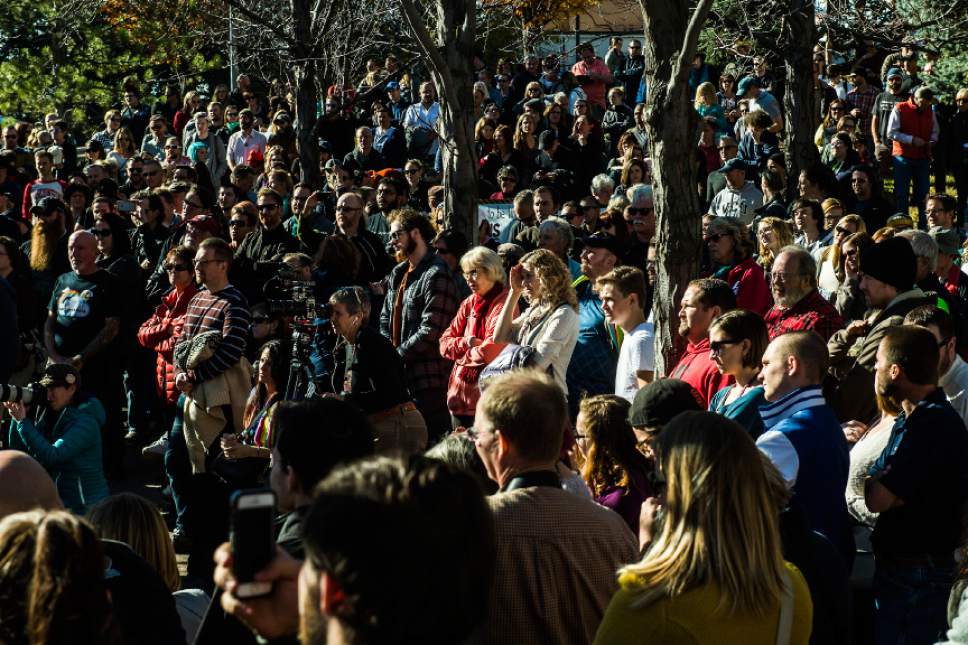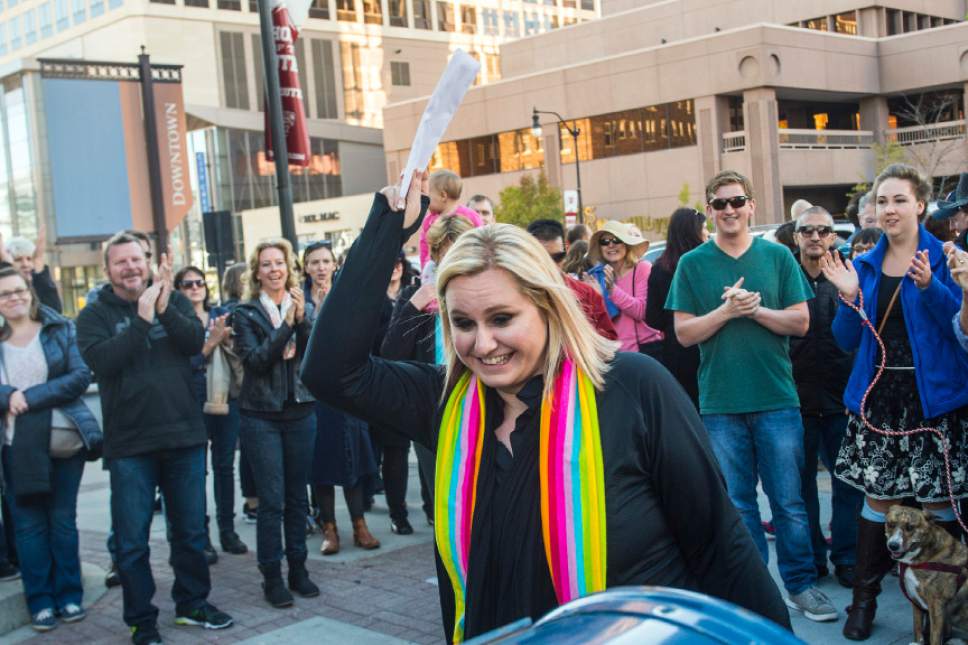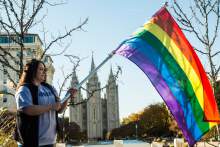This is an archived article that was published on sltrib.com in 2016, and information in the article may be outdated. It is provided only for personal research purposes and may not be reprinted.
The optics tell a stunning story of Mormon decline — or so many observers insist.
Photos of Mormons gathering en masse in a Salt Lake City park to quit their church officially and openly — accompanied by video images spinning around the globe — suggest the LDS Church is enduring an enormous, even unprecedented exodus.
The trouble with those visuals, according to church calculations, is that they distort the real picture. While the departures certainly loom large for the individuals involved, their overall numbers remain relatively small in the scope of one of the world's fastest-growing religions.
Signs of Mormon out-migration began mounting after the Utah-based faith adopted a policy in November 2015 labeling same-sex couples "apostates" and denying their children religious rituals of baby blessings and baptisms until they turn 18. Outrage ensued, in news reports, online denouncements and letters to local LDS bishops.
Attorney Mark Naugle, a former Mormon in South Jordan, says he has personally submitted about 12,500 letters to the LDS Church in the past year from members asking to have their names removed from the faith's membership rolls. He has received requests from most states, Naugle says, as well as from Japan, New Zealand, Thailand, France, Germany, Great Britain and South Africa, to name a few.
"And there are plenty more," he says, "who tell me my services are not necessary" — that they know how to excise their memberships without his help.
The LDS Church acknowledges "periodic increases or decreases in [such] requests," explains spokesman Eric Hawkins, but "the number of people asking to have their names removed from the records of the church has been less than one-tenth of 1 percent (less than 1 in 1,000) for more than 20 consecutive years, including in 2015 and the first eight months of 2016."
That means of the 15,634,199 members reported by The Church of Jesus Christ of Latter-day Saints in April, fewer than 15,634 have or will resign this year.
That figure pales in comparison to, say, the 257,402 converts who joined the church in 2015.
Hawkins says other "important statistics" demonstrate the continuing "activity [rate] of individual adult members, such as endowed members with a current temple recommend and full tithe payers."
In all areas, he writes in an email, "the upward growth has continued [during that same period]."
—
Grass-roots growth • Colorado-based Mormon demographer Matt Martinich says data from independent sources confirm the church's assessment of resignations.
"This is consistent with what our research has found in regards to trends in resignations," says Martinich, who works with the website cumorah.com.
Of course, being on the rolls does not necessarily mean sitting in the pews. The demographer estimates "active" Mormons make up about 40 percent of the total 6.5 million members in the United States. That percentage falls to 25 percent outside the U.S. and about 30 percent for the church as a whole. So millions of members on the rolls no longer participate, but they haven't resigned either.
Evidence that Mormon membership is holding steady, Martinich says, is that congregational growth rates remain stable — if not slightly increasing. Because the church relies on committed volunteers to lead and staff congregations (wards), if those numbers go up, that means there are more active members in those areas.
Even so, LDS leaders lament the loss of just one member.
They "don't want to see anyone leave the church," Hawkins says. "We must continue to extend love and respect to those who leave, and we would warmly welcome any who may desire to return."
Some do.
Two years ago, Aaron Brown worked with an LDS ward in Seattle to reach out to gays and lesbians who remained on the Mormon lists, some of whom rarely attended services. Local leaders urged all such members to come to a meeting — no pressure, no questions, no judging, just love.
Since the policy on gays became public — on Nov. 5, 2015 — one ward in Brown's stake (a regional group of LDS congregations) saw about two-thirds of the 15 or so gays who had been regularly attending walk away, while even more straight Mormons in that ward left.
Some of those in the latter group, Brown has learned, are slowly returning.
"It's hard to know for sure how many people have headed for the exit because of the policy, and for how many the exit will be temporary, rather than permanent," Brown says. "But even for many who stay, I suspect their relationship with the church has permanently shifted."
—
The road back • Gordon Tanner, president of an LDS stake in Redmond, Wash., for nearly a decade, says he had seen only a handful of voluntary resignations a year during the bulk of his tenure. In the past 12 months, however, 15 have asked to have their names withdrawn — some on their own initiative and others as a result of a periodic checking of the rolls.
From time to time, Tanner has his clerks sift through the records to see if any nonattendees want to be removed.
"Mostly, it's not an intellectual disagreement for them," Tanner adds. "They say, 'It's just not my church any more.' "
As for members who are disciplined by the church (as opposed to those asking that their names be erased), most are excommunicated, disfellowshipped or put on probation for moral sins such as adultery.
Tanner declines to elaborate on specific cases or reasons for the discipline, since the proceedings are confidential, but notes that of 14 stake-level disciplinary actions, 11 members have been rebaptized.
Some of those who leave or lose their membership privileges "are not coming back," he says. "Something has gotten them to that point."
Many others, though, yearn to return "to full fellowship" with the Latter-day Saints.
"My approach is to tell them this is a process by which they can reconcile themselves to God," Tanner says. "They should welcome the chance to reboot — sometimes it's a hard reboot, sometimes a soft one — but it's always worth it."
A Mormon father in Centerville knows the feeling. He has been excommunicated and rebaptized — twice.
The first time was soon after he returned from his two-year Mormon mission when he got his then-girlfriend pregnant.
She had the child, but they never married. Still, she pressured him to repent and return to the fold — which he dutifully did.
The couple eventually broke up, though, and Sidney (who asked to be identified only by his middle name due to the sensitive nature of his experience) began "womanizing, gambling and boozing." LDS leaders ousted him again.
Along the way, Sidney worked in financial services and felt he was justified in his hostility to the church of his childhood because he was mistreated, shunned and even swindled by active Mormons, including bishops.
Finally, in January 2015, came a knock on his door.
It was his LDS friend, offering to give him a "blessing," or prayer directly about him. The startled excommunicant agreed, and the man beseeched God to envelope Sidney in love.
In that moment, Sidney experienced a spiritual reawakening.
Within three months, he had confessed his sins to a Mormon bishop and was approved for rebaptism. He now leads a weekly scripture study and feels reborn.
"If anyone has been offended by some church leaders, I have. But that is irrelevant to my relationship with the savior and my Heavenly Father," he says. "I want to be a member and live the right way."
Twitter: @religiongal







